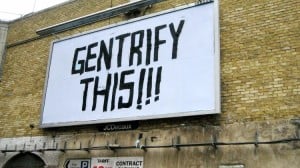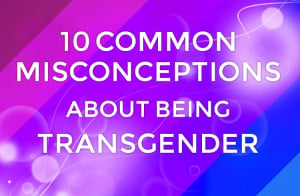
Source: Hart Schaffner Marx
I’m a “young professional,” and professionalism is one of my least favorite social constructs.
When we’re told that we need to look or act professionally, we rarely recognize that it’s code for “appear, as much as possible, as if you’re something you’re not and never want to or could be.”
In office environments especially, standards of professionalism are the law of the land – and they reinforce social hierarchies that value white maleness above all.
As an office-dweller, I’ve become acutely aware of how professionalism manifests in 9-to-5 environments – and I’ve had plenty of experience with how uncomfortable it makes me.
People like me – queer people, women, people of color, working-class people – aren’t supposed to be comfortable when we’re being professional.
Not to go all “anti-capitalist regime,” but professionalism is a tool of the elite to keep workforces “in their place” – and often, that place is defined in opposition to communities of color, queer culture, and the actual working class.
Professionalism reinforces a lot of ugly “isms” and often intrudes in our lives silently and without any expectation of objection.
For people like me, being asked to be more professional is sometimes a direct affront to who we are.
Looking the Part
Landing my first office job required me to create an entirely new wardrobe for myself full of “work clothes,” a task I found completely bewildering.
After all, what’s a “work outfit?” I’d completed tons of internships and jobs by the time I settled into a 9-to-5, and most of them simply required that I rolled out of bed on time to make my way in for the day.
I was experienced, skilled, and efficient – and all I wanted to do was jump into the work. It was strange that the one thing I needed to do first was go shopping.
After all, none of the work that I do is impacted by what I’m wearing, and the work I do should speak much more loudly than how I look.
Plus, on top of these questions, I was left wondering how I was supposed to afford clothing coming out of 14 months of relative underemployment, with little to no savings stashed away for pants and blouses from H&M.
I’m lucky to work somewhere with a relaxed dress code, even if I still have to wear slacks.
Unfortunately, employers typically require their workers to follow a formal or semi-formal dress code in the office – and at the root, it’s mostly about making appearances.
Often, these dress codes make “professional” realms exclusive to people who can’t afford to look a certain way when they leave the house, and often those dress codes are meant to create a visual hierarchy between “professional” people and the rest of the world.
I live in Washington, DC, and this city is a huge suit store. It’s assumed that you have a blazer hanging in your office at all times if you’re like me and you don’t wear one to work, and the rest of the masses trudge back and forth in rain, sleet, and snow in impractical dress clothes and shoes.
It’s not that all of the lawyers, lobbyists, politicians, and nonprofit sector employees here need to wear this stuff to work – it’s that the power structures in place here demand us to wear this stuff to earn respect.
I’m not into that.
One of the reasons I’ll put on that blazer in my office is to head to Capitol Hill. If I’m going to a meeting or an event in or around the halls of Congress or the White House, it’s expected that I show up dressed to the nines.
This stirs up a lot of questions. Why can’t elected officials take me seriously in my actual clothes, being my actual self? Why do I have to dress a certain way just to interact with them?
And it isn’t just the Hill. It’s a phenomena in offices everywhere. When the board of directors comes to town, you put on sleek skirt and pant suits.
When CEOs comes to check out your department, you throw on your favorite dress. Our mentors tell us to “dress for the job you want, and not the job you have.”
The problem isn’t that we want to look good. It’s that when we want to look our best at work, sometimes we can’t look like ourselves.
Wearing suits instead of sundresses because I have to feels like being told that the who I really am – underneath the dress pants and pencil skirts – isn’t good enough to be there.
That’s hierarchy in action. That’s not okay. Every single person in every single office should be taken seriously and treated with respect no matter what they’re wearing.
It isn’t just the logic behind dress codes, however, that makes them largely problematic.
Dress codes make room to turn a lot of “isms” into policies – especially since typical standards of professional dress are, at the core, racist, sexist, classist, and xenophobic.
For workers who come from a non-Western background, for example, workplace dress codes can invisibilize them. What folks see as professional garb rarely encompasses non-Western dress.
For Rastafarian or Muslim employees, dressing or appearing in line with your faith becomes a vulnerability. Employers might be critical of dreadlocks or religious accessories or symbols, which puts those particular non-white workers in a disadvantaged position to move ahead in their professional lives.
Women of color, meanwhile, still face objections to their own natural hair in the workplace.
It can also be burdensome to subscribe to a dress code when it means subscribing to a gender binary that doesn’t speak to your experiences.
More femme identified men might have trouble striking a balance between what’s “professional” and what feels right, and androgynous or genderqueer folk might be forced to dress in a more binary, and consequently oppressive, way.
Women face a unique conundrum – namely, that they can’t be seen as “too feminine” or “too masculine,” and that different occasions will call for different apparel.
I remember being told once that I should wear pants, not a skirt, to the Hill – as if wearing a dress or skirt somehow undermined me as a worker in a historically male institution.
For some women, dressing in traditional male garb helps them to gain power, but in some workplaces, it works to their detriment because their colleagues find it inappropriate.
On the flip side, women might be received more warmly clothed in dresses and soft blouses, but will also be dismissed as flitty, unserious, and unintelligent.
For workers without money, dressing “professionally” can actually be an impossible request.
When workers at all levels are expected to dress formally, the workers bringing in the least income must choose between saving up or dressing up – and often, the cost of going without the right shoes, shirts, or dresses can cost them promotions and other opportunities in their career.
When you parse out professional standards of appearance, it becomes easy to spot the kyriarchy embedded in each expectation. That’s because professionalism is a vanguard of the old days, when boys’ clubs ruled the world. (And right now, they pretty much still do.)
All of the standards of appearance being pushed on employees in office environments are, essentially, strongholds of white, male standards of power.
By being held responsible to look the way professionalism pressures us to look, we’re being held responsible for appearing as rich, white, and male as we can.
Acting the Part
Professionalism is a code that extends beyond how we look – it’s also about how we act. In fact, professionalism is what gives employers the opportunity to police our behavior in the workplace, as well as to comment on it.
It’s what runs through our head when we’re tempted to call someone out at a meeting. It’s what stops us, sometimes, from being able to communicate effectively and solve problems at work.
Often, the way professionalism dictates we should act at work also falls in line with stereotypes and predetermined roles based on our race, sex, gender, or class.
Women, for example, are expected to be subservient and apologetic in the workplace, whereas men are rewarded for being pushy, ambitious, and outspoken.
Professionalism also dictates that employees stay calm and cool during work hours and show little to no emotion – which, in a coded way, prioritizes the masculine over the feminine.
Not being able to express ourselves authentically is a societal expectation rooted in what we called “hegemonic masculinity” in my gender studies class – a deeply ingrained cultural expectation that men all look, behave, and act according to the highly policed model of what “being a man” is.
That model hurts all of us, even men, by forcing us to adhere to societal expectations that negatively impact our emotional and physical well-being.
People of color might find that their language and behavior is heavily monitored and policed at work – and used against them.
Often, this is because the way they act fails to fall in line with “respectability politics,” which demand that people of color go out of their way to assimilate into the dominant white culture.
“Respecting authority” at work and the expectation that employees should be “all-in” to a culture that might be at odds with whom they are is also a part of this social code.
When professionalism demands we are implicit in our workplace culture and hierarchy, it is a direct roadblock to social progress.
Hierarchies are inherently unequal, and not being able to challenge power structures should never be key to moving ahead in life. But in a professional environment, challenging the power structure – be it through your behaviors or your appearance – is unacceptable.
In the professional world, causing a stir is supposed to be the last possible option – and talking back to your superiors can be grounds for termination.
Challenging your transphobic boss can ruin or strain your relationship with them, even if you’re right. Going against the rules to do the right thing for a co-worker struggling to balance their work and family obligations can be seen as incompetence if your supervisor decides so.
Even asking for help is seen as a sign of inferiority in some workplaces – which, again, is part of the patriarchal laws of power.
For some folks, being part of a hierarchy – and subject, without room to object, to the whims of their superiors – has become an inextricable part of going to work.
This kind of struggle extends to the relationships we build at work outside of those with our supervisors, though.
For LGBTQIA+ workers in office environments that are homo- and/or transphobic, it might be understandably difficult for them to forge close relationships with their colleagues, and that might mean that they feel less comfortable suggesting ideas or taking risks at work.
For many of those workers, giving up the social aspect of their jobs also means giving up a chance to get ahead or network out to another employer.
Similarly, a person of color in an all-white work environment might feel at odds with the people they work with.
More likely, those workers will also witness acts of outright racism or be assailed with racist microaggressions by their superiors or colleagues on a regular basis.
By calling people out on their racist behavior, they could risk everything; but by staying quiet, they’re doing harm to themselves.
A tenet to professionalism is supposed to be being able to work with other people – even if those people say and do awful things.
Leaving a job because you experienced racist or sexist behavior on the regular might seem very valid to us as objective outsiders, but explaining to a potential boss that you left your job because your white coworkers were insensitive to you could be seen as a weakness or failure on your part.
Not being able to push through it – no matter how terrible it is – becomes the workers’ fault, not the workplace’s fault.
When employers use professionalism to police behavior, they take agency away from their workers. And standards of professionalism leaves those workers without much recourse.
***
Although a lot of the concepts I explored here took place in theoretical office environments, it’s not just those worlds in which standards of professionalism are used to mainstream workers into a common ideal identity.
Workers of all walks of life have been asked to change their clothes, their hair, their attitude, and themselves to fit in, excel, succeed, or continue at work – and for workers in less secure positions than those of 9-to-5’ers, the stakes are even higher.
As a professional and a feminist, I do my best to create safe, comfortable, and productive spaces at work. I keep blazers in my office and heels in my bookcase, but I’m just as down to work in jeans as I am to work in a skirt suit. (And I’ve managed a staff in rompers and crop tops many, many times.)
What matters isn’t how we look or which slang we throw around, and office environments where people feel free to be themselves and express themselves are offices where employees are more engaged, happy, and successful.
When we let people settle into their jobs as who they really are, they feel more connected to their colleagues and less resentful toward their employers.
“Professionalism,” like all social constructs, is a total downer. And if it’s the work that really matters, we’ll let go of it.
[do_widget id=”text-101″]
Carmen Rios is a Contributing Writer for Everyday Feminism. She splits her time disparately between feminist rabble-rousing, writing, public speaking, and flower-picking. A professional feminist by day and overemotional writer by night, Carmen is currently Communications Coordinator at the Feminist Majority Foundation and the Feminism and Community Editor at Autostraddle. You can follow her on Twitter @carmenriosss and Tumblr to learn more about her feelings. Read her articles here.
Search our 3000+ articles!
Read our articles about:
Our online racial justice training
Used by hundreds of universities, non-profits, and businesses.
Click to learn more




















